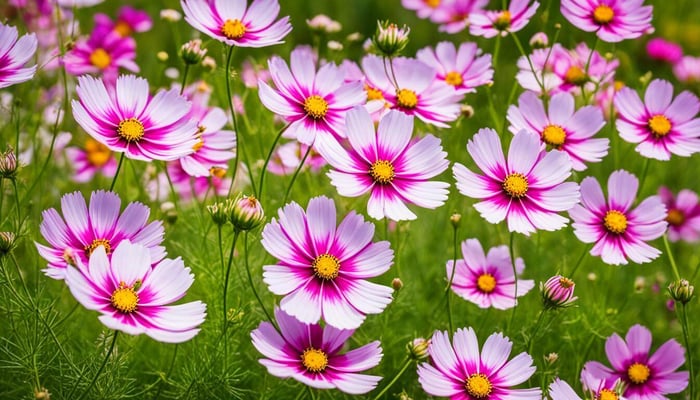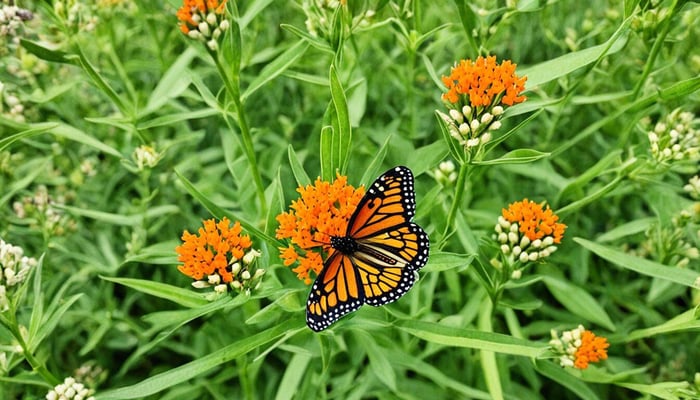At first glance, the prospect of a single plant luring scores of butterflies and bees might seem far-fetched, yet the Cosmos bipinnatus 'Candystripe' does just that. This annual flower is not just a visual feast with its vibrant striped petals but a botanical magnet for pollinators. With ample sun, the cosmos can grow abundantly in the right conditions, creating a hive of activity in any garden space. Their easy-to-grow attribute makes them a favorite among green thumbs and casual gardeners, promising a spectacular display and a thriving ecosystem with minimal effort. Let's learn how to grow candystripe (Cosmos bipinnatus) from seeds.
Key Takeaways
- Candystripe Cosmos, known for their striking appearance, are excellent at drawing in pollinators, which play a key role in the health of our gardens.
- These annual flowers are well suited to grow in areas that receive full sun, enhancing their bloom vitality and overall garden aesthetics.
- One of the most attractive features of Candystripe Cosmos is its ease of cultivation, offering an accessible gardening venture for enthusiasts of all levels.
- Completing their life cycle in a single year, Cosmos bipinnatus assures gardeners a yearly renewal of beauty and pollinator attraction.
- The bold, striped patterns of the Candystripe variety add a unique dimension to your garden, setting it apart from the common floral displays.
Candystripe Cosmos Seeds Basics
- Days till maturity: Candystripe Cosmos typically take about 70 to 84 days from seed to bloom. This period allows the plant to fully mature and produce distinctive striped flowers.
- Planting depth: The seeds should be sown at a shallow depth of about 1/4 inch (6 mm) beneath the soil surface. This shallow planting depth ensures they receive enough light for germination, which is crucial for cosmos seeds.
- Plant spacing: When planting Candystripe Cosmos, space the seeds or seedlings about 12 to 18 inches (30 to 45 cm) apart. This spacing allows room for each plant to grow and ensures good air circulation, reducing the risk of fungal diseases.
- Days to germination: Cosmos seeds typically germinate within 7 to 21 days after sowing, depending on the soil temperature and moisture levels. Keep the soil consistently moist but not waterlogged during the germination period.
- Indoors or Direct Sown: Cosmos bipinnatus can be started indoors and directly sown. Starting seeds indoors 4 to 6 weeks before the last frost date gives you a head start on the growing season. However, they also germinate and grow easily when sown directly in the garden after the last frost when the soil has warmed.
- Full Sun or Partial Shade: Candystripe Cosmos thrive best in full sun but can tolerate partial shade. However, plants grown in full sun will produce more blooms and have a sturdier growth habit.
- When to harvest: Cosmos flowers can be harvested throughout the growing season, usually around 70 to 84 days after sowing, once the blooms are fully open. Regular harvesting of flowers encourages continuous blooming.
- How tall does the plant get?: Candystripe Cosmos can grow about 3 to 5 feet (90 to 150 cm) tall, depending on the growing conditions and the variety.
- How wide does the plant get?: The plant can spread about 1 to 2 feet (30 to 60 cm) wide. Ensure adequate spacing to accommodate this growth.
- Native: Cosmos bipinnatus is native to Mexico. Its adaptability, however, has made it a beloved flower in gardens worldwide.
- Family: Cosmos bipinnatus belongs to the Asteraceae family, the same as daisies and sunflowers. This family is known for its vibrant, flowering plants often used in ornamental gardens.
Cosmos Candystripe Seeds
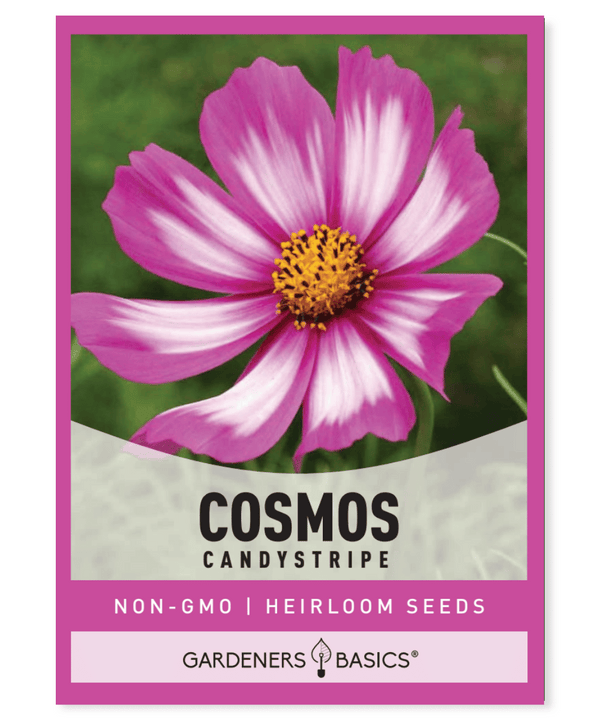
$2.49
Candystripe Cosmos Seeds – Heirloom, Non-GMO, Open-Pollinated, Non-Hybrid – Perfect for a Stunning Garden Display Grow breathtaking Candystripe Cosmos flowers with our premium heirloom seeds! These stunning annuals showcase delicate white petals adorned with vibrant pink edges, creating a striking… read more
Understanding Candystripe Cosmos and Their Ideal Conditions
Delving into the world of Candystripe Cosmos reveals more than just a striking floral display; it showcases a flower that is a true marvel of horticulture. Growing cosmos adds an artistic splash to gardens and contributes significantly to local ecosystems. For garden enthusiasts looking to enhance their landscapes, understanding the unique aspects of these blossoms and the conditions they require is crucial for successful cultivation.
Characteristics of the Candystripe Variety
The Candystripe variety of Cosmos bipinnatus is distinguished by its bi-colored petals, which are commonly striped with white and deep pink hues. The plant can reach an impressive height of up to four feet with bloom sizes that can span several inches. These show-stoppers are perfect for creating a visual impact in any garden space. Planting the cosmos reasonably can yield a bountiful and spectacular floral show.
Benefits of Growing Cosmos in Your Garden
Planting the cosmos serves dual purposes: to excite the eyes and to enrich the garden. Cosmos flowers provide an essential service by attracting pollinators, thus playing a pivotal role in a garden's biodiversity. Their long blooming season ensures a continuous parade of bees and butterflies, which not only aids other plants but also augments the local environment's health. Additionally, the cosmos' easy-to-grow nature assures gardeners of all skill levels a high-reward experience.
Optimal Climate for Germination
To kickstart the journey from cosmos seeds to flourishing plants, it's vital to understand and provide the optimal climate for germination. These seeds favor warm soil and consistent sunlight. Ideal temperatures for germination range from 70°F to 85°F, which is good news for those in warmer regions intending on growing cosmos. Once planted, these hardy flowers will embark on their growth journey, eventually arriving as the radiant beacons of color that are the Candystripe Cosmos.
Aspiring to cultivate your own tribute to the growing cosmos within your garden will call for patience, attention, and the following ideal conditions:
| Condition | Requirements | Notes |
|---|---|---|
| Temperature (°F) | 70° to 85°F | Ideal range for cosmos seed germination |
| Soil Type | Well-draining | Avoid waterlogged soil to prevent rot |
| Light Exposure | Full sun | At least 6 hours of direct sunlight daily |
Starting Your Cosmos Seeds Indoors
The journey begins with the seed indoors approach for gardeners looking to get a head start on their Candystripe Cosmos. This indoor kickoff protects seeds from late frost and provides the warmth and care needed to foster robust seedlings. Let us delve into timing, soil mix selection, and soil temperature management for optimum germination success.
Timing: When to Begin Seed Indoors
Our quest for a luscious, pollinator-friendly garden starts inside before the last frost threatens. We generally advise initiating the indoor seeding process about 4-6 weeks before the estimated end of frost. Aligning your sowing schedule with local climatic patterns ensures your seedlings are hearty and mature enough to transition outdoors when the time comes.
Choosing the Right Soil Mix
Laying the foundation for germination with the right soil mix can't be overstated. We're looking for a well-draining, nutrient-rich medium—conditions that Candystripe Cosmos seeds adore. Peat, perlite, and vermiculite-based soil mixes strike that perfect balance, providing aeration and moisture without the unwanted soggy feet that risk root rot.
The Importance of Soil Temperature
As with the comfort of our homes, soil temperature plays a pivotal role in the life of a germinating seed. Aim for a snug soil temperature of around 70°F to 80°F, which is the Cosmos seeds' preferred warmth for waking up. Too cool and you risk dormancy; too hot and you may impair their potential. A simple soil thermometer can be your ally, keeping your indoor nursery at just the right degree. Remember, our Candystripe companions are drought-tolerant once established, but they rely on us to get the conditions right during their formative days.
| Action | Details | Benefits |
|---|---|---|
| Start Seeds Indoors | 4-6 weeks before the last frost | Protects from extreme weather, fosters healthy growth |
| Select Soil Mix | Well-draining, peat-based mix | Promotes aeration and moisture balance, preventing rot |
| Maintain Soil Temperature | 70°F to 80°F for germination | Ensures a conducive environment for seedling development |
Planting Cosmos Seeds in the Garden
With warmer days on the horizon and the danger of frost retreating into memory, we find ourselves at the perfect juncture to introduce Cosmos seeds to their new home—the garden. In this next stage, we'll navigate the intricacies of outdoor planting, from precise timing post-frost to strategic spacing and creating a sanctuary for those precious pollinators.
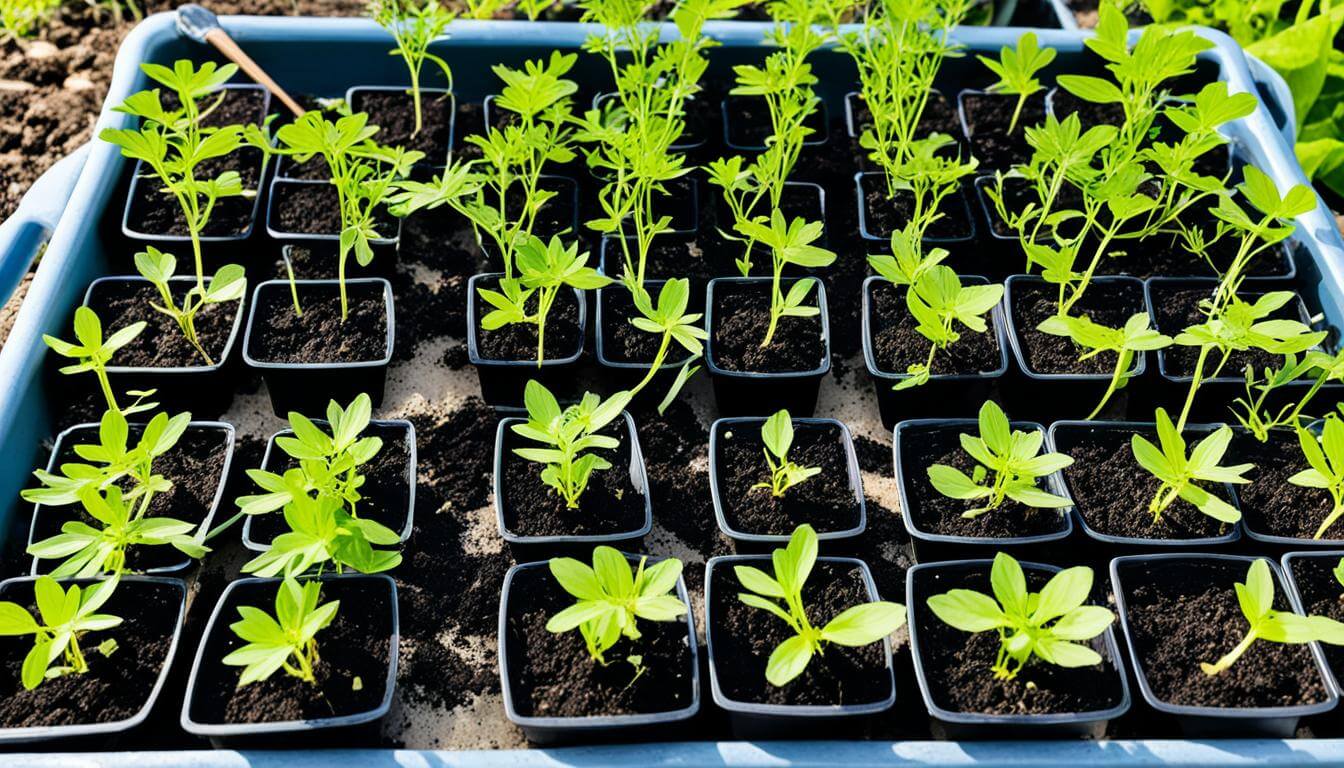
When to Plant After the Danger of Frost Has Passed
Mark your calendars, for timing is everything when transitioning your Cosmos seedlings outdoors. The whisper of spring brings promise, yet we must wait until the final frost yields its grip. To ensure seedling survival, the threat of any icy comeback must disappear. As the steadier warmth sets in, generally two weeks after the last frost date, it's safe to unveil your green protégés to the elements.
Spacing Requirements for Healthy Growth
Space—no, not the final frontier—but an essential consideration for nurturing your vibrant cosmos to reach an inches-tall stature. Proper spacing, typically about 18 inches apart, allows each plant sufficient room to flourish. This measured detachment encourages ample sunlight reception and air movement, minimizing moisture retention that could invite disease. Here's a guiding principle: plant just as eagerly as you would attend a dance, where every step and twirl counts for form and grace.
Creating an Environment to Attract Pollinators
You'll need more than green fingers to transform your patch into a buzzing utopia. Cosmos, by design, are adept at summoning an entourage of bees and butterflies. Nevertheless, setting the stage to attract pollinators into your garden's narrative involves harmonious companion planting with other nectar-rich flora. In concert, the color and fragrance compose an irresistible siren's song for our winged allies, ensuring a thriving ballet of pollination.
Remember: patience paired with these critical steps will yield an eye-catching display of the Cosmos and forge a rich tapestry of biodiversity, adding vigor and sustainability to your garden haven.
Wildflower, Perennial, & Annual Flower Seed Kit | 35 Variety Pack
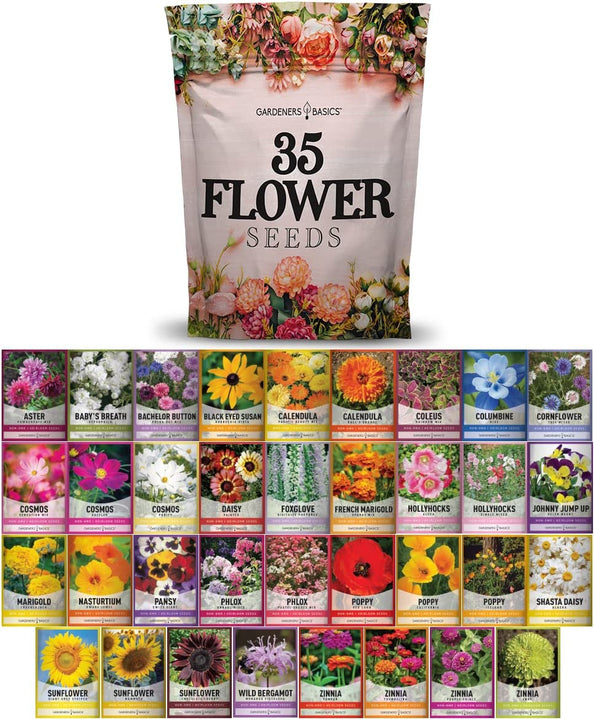
$29.95
$49.95
35 Flower Seeds Variety Pack – Heirloom, Non-Hybrid, Non-GMO, Open-Pollinated – Perfect for Pollinator-Friendly Gardens Transform your garden with our 35 Flower Seeds Variety Pack, offering a stunning and diverse selection of heirloom, non-hybrid, and non-GMO seeds. Each variety in… read more
Caring for Your Candystripe Cosmos Seedlings
In our garden pilgrimage, the cosmos flowers stand as starry ambassadors of vibrancy and life, demanding our attention and care. A dance with the sunlight is essential for these celestial blooms to unfurl in all their glory. Within the realm of full sun, the cosmos seedlings find their true potential, basking in at least six hours of sunshine to thrive. Watering, while a fundamental part of care, is a delicate art. We provide enough moisture to keep the soil slightly damp but not waterlogged, maintaining a balance that encourages but does not drown our burgeoning flora.
Now, as we nurture our candy stripe progenies, pondering upon the fertility of their earthly beds becomes crucial. These cosmos seedlings often flourish without much fuss over soil additives. If anything, they prefer not being too pampered. Yet, should your garden's ground be lacking, a light touch of a balanced, slow-release fertilizer can be introduced. But let us not be overzealous with our feed, for the cosmos's native resilience makes them adept at prospering in less-than-perfect soils.
| Care Aspect | Recommendation | Frequency & Amount |
|---|---|---|
| Watering | Keep soil slightly damp | Adjust based on weather; do not overwater |
| Sunlight Exposure | At least 6 hours of full sun daily | Monitor throughout the day |
| Soil Fertility | Use balanced fertilizer if needed | Sparingly, only when natural soil is deficient |
Loving care and mindful watch over these aspects lead our cosmos seedlings to bless us with blooms. We revel in the knowledge that in our hands lies the power to coax forth from the earth such wondrous sights—the cosmos flowers reaching out to the full sun, painting our gardens with the hues of the heavens.
Transplanting Seedlings to Outdoor Spaces
When we shift our cosmos seedlings from their sheltered starts to the great outdoors, we engage in a critical process that ensures a seamless transition to their new, sun-drenched habitat. This pivotal moment in gardening requires gentle hands and knowledge of transplanting seedlings effectively, with special attention to their need for full sun and adaptation to external conditions.
Acclimatizing Plants Before the Outdoor Move
Hardening off seedlings is akin to preparing them for a big adventure—they must adapt to the elements, especially the full sun, which will define their existence. Here's how we can acclimatize our cosmos seedlings:
- Gradually introduce your cosmos seedlings to the outside world, exposing them to filtered sunlight and sheltered breezes for a few hours daily.
- Incrementally increase their exposure over 7-10 days, allowing the seedlings to endure longer periods in the sun and tougher weather conditions.
- Ensure they have ample water and monitor their response closely—they'll tell you if the transition is too swift or just right.
Once the seedlings stand tall and confidently under the open sky, they're ready for the move.
Transplanting Techniques for Cosmos Seedlings
Our cosmos seedlings are ready to dig their roots into the earth and bask in the sun's glory. Here is a step-by-step guide to transplanting:
- Choose a mild and overcast day to prevent transplant shock from harsh sunlight.
- Prepare the new outdoor space, ensuring that it provides full sun exposure and the soil has been loosened for easy root insertion.
- Carefully remove seedlings from their containers, handling the delicate roots to avoid damage.
- Plant seedlings at the same depth they were in their containers to provide a sense of continuity for the plants.
- Space seedlings out according to the recommended guidelines, generally around 12-18 inches apart for cosmos.
- Water thoroughly after transplanting to aid in settling the soil around the roots and to provide essential hydration.
- Mulch lightly around the base of each seedling to conserve moisture and deter weeds.
Note: While cosmos seedlings are hardy, our care in transplanting them defines their ability to flourish under the full sun's embrace.
Mindful attention to these transplanting steps will help our seedlings adapt to their new outdoor environment, ensuring their vitality for a blooms-filled future.
Maintaining Healthy Growth of Cosmos Flowers
Once the vibrant seedlings of Cosmos bipinnatus, an easy-to-grow annual flower, have rooted firmly in their sun-kissed beds, we must commit to a caretaking ritual that ensures their continued health and splendor. Tending to these drought-tolerant beauties is joyful, as they graciously reward our gardens with floriferous displays.
Our role in maintaining these full-sun companions involves understanding their needs—moderate yet consistent watering, basking in the warmth of unfiltered daylight, and a vigilant eye for any signs of distress.

| Care Task | Best Practice | Reason |
|---|---|---|
| Watering | Regular, deep watering | Encourages deep root growth; needed less often once established |
| Sunlight | 6+ hours of direct full sun | Maximum bloom production necessary for healthy foliage |
| Soil Monitoring | Check for proper drainage | Prevents root rot in this drought-tolerant species |
| Fertilizing | Light, balanced feeding if the soil is poor | Supports continuous blooming without promoting legginess |
In caring for Cosmos bipinnatus, we should focus on a few simple tasks. Watering, for instance, should be done deeply yet infrequently, fostering resilience within these sturdy stalks, allowing them to stand tall against the harsh heat of high noon. Although they are drought tolerant, young plants will benefit from consistent moisture until they're fully established.
When it comes to sunlight, these annuals are sun worshipers; thus, a location that basks in full sun goes without question. Direct light fuels their growth and feeds their lavish blooms, providing the energy necessary for a bountiful season of color and charm.
Routine observations are paramount—checking for drooping blooms, wilting leaves, or any discolored patches signals that our green charges might be distressed. Proactive intervention with these easy-to-grow specimens often leads to a quick remedy, whether it involves adjusting the watering schedule, providing some nutrient boost, or relocating them to a sunnier spot. Any signs of sickness, like mildew or pests, should be addressed promptly with eco-friendly solutions to ensure continuous thriving under our watchful stewardship.
Concluding this care summary, embrace your role as the guardian of these cosmos flowers. With a compassionate and attentive approach, your garden will remain a testament to the durability and splendor that is the signature of Cosmos bipinnatus.
Harvesting Cosmos Seed Heads
Expertly cultivating Cosmos in our gardens bestows us a new rite of passage—the harvest. When those delicate seed heads sway in the breeze, it is more than a signal of summer's end; it's an invitation to extend the life of our beloved flowers. Whether aspiring to gather seeds for next season's planting or seeking the charm of a cut flower for our vases, the timing and technique of this phase are paramount.
Timing Your Harvest for Optimal Vase Life
To ensure a prolonged vase life, one must strike when the iron—or the bloom—is hot. The key is to wait for that precise moment when the cosmos flowers exhibit vibrant petals and pollen-laden centers. Ideally, we cut the flower stalks early in the morning when the plant is most hydrated and before the afternoon heat, which can expedite wilting. The seed heads' readiness for harvesting cosmos depends upon their firmness to the touch and a color transition towards brown, signaling maturity.
Techniques for Harvesting Cosmos
With snips in hand, we approach the task with a strategic touch. Harvesting cosmos should be done with sharp, clean-cutting tools to prevent damage to the plant's structure. Approach the stem near the base and clip at an angle, which will also allow for better water uptake when the stem is placed in a vase. For those interested in harvesting seeds, allow the seed heads to dry on the plant until they are brown and crisp to the touch, and then carefully snip off the head while avoiding seed spillage.
| Harvesting Goal | Timing | Technique |
|---|---|---|
| Cut Flower | Morning, before the heat | Sharp cut at stem's base |
| Seed Heads | When heads are brown | Snip with care to collect seeds |
So there we have it, fellow gardeners. Whether we seek the joy of a vase adorned with cosmos flowers or the satisfaction of sowing their seeds anew, the love and skill in the harvest ensures our gardening efforts bear the finest fruits—or, in this case, the most enchanting seed heads.
Addressing Common Pests and Problems
Gardening is an art; like all art forms, it sometimes faces challenges. For us who cherish the vivid beauty of Cosmos bipinnatus, it's crucial to be vigilant against common pests that could tarnish our floral masterpieces. Through our collective experiences, we've come to identify and address the usual culprits that threaten cosmos seeds and blooms. Below, we explore proven methods to safeguard our gardens from these invasive pests and the cultural pitfalls that could compromise the health of our cosmos.
Starting with the common pests, aphids and thrips are the primary concern. These tiny invaders are notorious for sucking the sap from plants, weakening them, and potentially transmitting diseases. To tackle these issues organically, we often turn to solutions such as neem oil or insecticidal soaps, which are effective yet gentle on our environment. For those preferring a non-organic route, systemic pesticides can offer a more robust line of defense, albeit with a mindful approach to their impact on our ecosystem.
Moreover, environmental stressors like poor drainage or overcrowding can significantly influence the health of Cosmos bipinnatus. We must provide well-draining soil to avoid waterlogged conditions, which can lead to root rot, a silent slayer of many plants. Similarly, proper spacing is non-negotiable; crowded cosmos stands are a haven for moisture retention and disease spread. Our practice is to space seeds or seedlings about 18 to 24 inches apart, allowing each plant its rightful place in the sun.
We've compiled a table that illustrates our proactive regime against these common pests and conditions that may threaten the harmonious growth of our cosmos gardens:
| Pest/Problem | Organic Solution | Non-organic Solution |
|---|---|---|
| Aphids | Neem oil, strong water spray, introducing ladybugs | Systemic insecticides |
| Thrips | Insecticidal soap, predators like lacewings | Spinosad or other targeted pesticides |
| Poor Drainage | Elevate planting beds, improve soil composition | Install drainage systems, use raised beds |
| Overcrowding | Thinning seedlings, adequate initial spacing | Strategic pruning, fungicide treatments preemptively |
In our pursuit of horticultural excellence, we must always engage with nature attentively and respectfully. By facing off against common pests and reinforcing responsible gardening practices, we uphold the serene beauty of our cosmos collection, ensuring each seed has the opportunity to unfurl into a testament to our garden's vivacity.
Conclusion
As we draw to a close, it's clear that the journey of cultivating Candystripe Cosmos is more than just a gardening endeavor—it's an embrace of nature's artistry. From sowing seeds to the joyful harvesting of blooms and seed heads, cosmos flowers offer a narrative of growth and beauty that enchants every onlooker. These floriferous marvels not only bedazzle our gardens with their vivid patterns and hues but also serve as pivotal players in the ecological ballet of pollination. Moreover, their undemanding nature and robust annual bloom cycles ensure that gardeners of any level can partake in this horticultural triumph with minimal fuss.
Enjoying the Beauty of Candystripe Cosmos
Indeed, to cultivate cosmos flowers is to welcome an assembly of fluttering wings and to enjoy a perpetually changing canvas of color throughout the seasons. Our collective efforts in nurturing Candystripe Cosmos reward us with an unparalleled splendor that renews itself each year. This resilience and ease of care validate the joy we invest in tending to our patches of earthen delights and reinforce the myriad benefits these blooms bring to our personal sanctuaries of green.
Gardener's Basics: Where to Buy Cosmos Seeds
For those eager to commence their own Candystripe odyssey, acquiring quality cosmos seeds is the first stride towards a bounteous garden. Look no further than Gardener's Basics for a trove of cosmos seeds for sale, promising the genesis of vibrant growth. Gardener's Basics stands as a beacon for gardeners in pursuit of excellence, supplying seeds that promise a flush of cosmos flowers to adorn your outdoor spaces. So, gather your trowels, and let us join in ushering an era of natural aesthetics to the cosmos awaiting in our backyards.
Cosmos Seeds For Planting | 4 Variety Pack
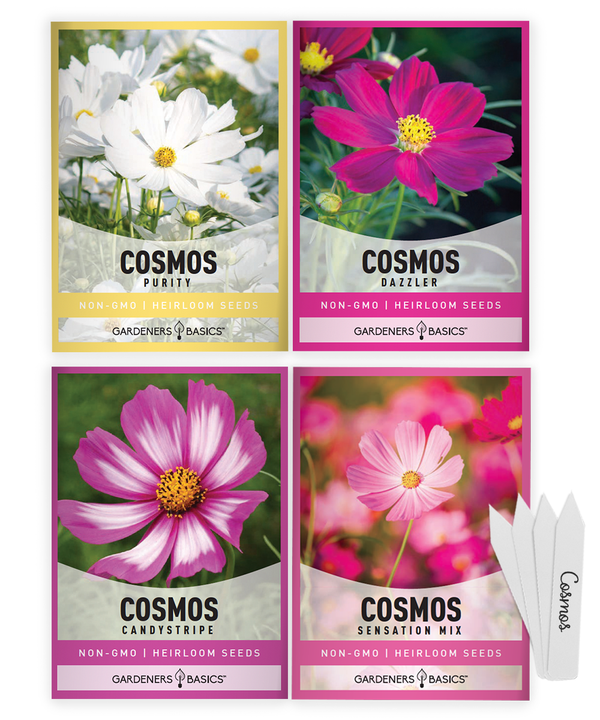
$7.95
Heirloom Cosmos Seeds – 4-Variety Pack for Vibrant, Non-Hybrid Blooms Introducing our premium 4 Cosmos Flower Seeds Variety Pack—perfect for gardeners of all experience levels looking to add vibrant beauty to their outdoor space or garden beds. This meticulously curated… read more
FAQ - How To Grow Candystripe (Cosmos bipinnatus) From Seeds
How do you grow Candystripe Cosmos from seeds?
To grow Candystripe Cosmos, plant the seeds in well-draining soil in a spot that receives full sun. Since they're annual flowers, they will complete their lifecycle within a year. Plant the seeds after the last frost, and ensure they have plenty of light as they grow because they are great at attracting pollinators and are quite easy to grow.
What are the characteristics of the Candystripe variety?
Candystripe Cosmos is known for its vibrant striped petals with a stunning color palette. They generally reach a height suited for garden displays and produce sizable blooms to be a focal point. Like other cosmos flowers, this variety can create a charming aesthetic in your garden while inviting beneficial pollinators.
When is the best time to start cosmos seeds indoors?
The optimal time to start cosmos seeds indoors is about 4-6 weeks before the last expected frost. This allows them to grow to a strong size for outdoor transplanting. Ensure the seeds are planted in a well-draining soil mix and kept at a consistent temperature to facilitate successful germination.
What are the proper conditions for planting cosmos seeds outdoors?
Cosmos seeds should be planted outdoors once the danger of frost has passed to ensure the seedlings aren't harmed by cold temperatures. Space the plants about 18 inches apart to provide ample room for growth and to promote good air circulation. Also, consider the overall garden environment to ensure it's inviting to pollinators.
How should I care for my Candystripe Cosmos seedlings?
Make sure your Candystripe Cosmos seedlings receive full sun once they're established. Water them regularly, but ensure that their soil remains well-draining. Cosmos flowers do not typically require extra fertilization if planted in fertile soil. Monitor the plants, provide support if needed, and check for signs of stress or disease.
How do I acclimate and transplant cosmos seedlings to outdoor spaces?
To acclimate your cosmos seedlings to outdoor conditions, gradually expose them to full sun and outdoor temperatures over 7-10 days. This process, known as hardening off, is essential to prepare the plants for the transition. When transplanting, carefully handle the root systems to avoid stress and ensure their best chance for continued growth in the garden.
What ongoing care practices help maintain healthy cosmos growth?
To maintain healthy growth, water cosmos regularly, especially during periods of drought, as they are drought tolerant but do best with consistent moisture. Cosmos thrive in full sun, so position them to receive adequate light. Watch for pests or signs of disease and intervene early with appropriate measures.
When is the best time to harvest cosmos seed heads for cut flowers?
The best time to harvest cosmos seed heads for cut flowers is in the morning when they are freshest. Aim to cut the stems when the flowers open for the longest possible vase life. Use clean, sharp scissors or pruners, and place the flowers in water immediately for the best results.
How can I address common pests and problems in cosmos flowers?
Identify the pests affecting your cosmos flowers, such as aphids or thrips. You can use organic methods like neem oil or insecticidal soap to control these pests. To avoid problems caused by environmental conditions, ensure proper spacing, adequate sunlight, and good drainage to keep your cosmos plants healthy.
Where can I buy high-quality Candystripe Cosmos seeds?
High-quality Candystripe Cosmos seeds can be purchased from our online seed store at Gardeners Basics.



